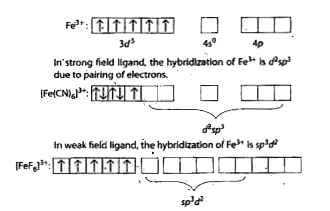The correct statement about the magnetic properties of and is : Solution in Malayalam
both are paramagnetic
both are diamagnetic
is diamagnetic, is paramagnetic
is parainagnetic, is diamagnetic
The correct Answer is:A
In and the electronic configuration of is
 In both complexes unpaired electrons are present. Thus, both complexes are paramagnetic.
In both complexes unpaired electrons are present. Thus, both complexes are paramagnetic.
Topper's Solved these Questions
- BOOK - BRILLIANT PUBLICATIONCHAPTER - COORDINATION COMPOUNDS EXERCISE - LEVEL-II50videos
COORDINATION COMPOUNDS
- BOOK - BRILLIANT PUBLICATIONCHAPTER - COORDINATION COMPOUNDS EXERCISE - LEVEL-II (ASSERTION- REASON TYPE )20videos
COORDINATION COMPOUNDS
- BOOK - BRILLIANT PUBLICATIONCHAPTER - COORDINATION COMPOUNDS EXERCISE - LEVEL III (Linked Comprehension Type) (Paragraph IV)3videos
COORDINATION COMPOUNDS
- BOOK - BRILLIANT PUBLICATIONCHAPTER - CO-ORDINATION COMPOUNDS AND ORGANOMETALLICSEXERCISE - Level-II (Assertion- Reason)4videos
CO-ORDINATION COMPOUNDS AND ORGANOMETALLICS
- BOOK - BRILLIANT PUBLICATIONCHAPTER - D & F BLOCK ELEMENTSEXERCISE - Level -II38videos
D & F BLOCK ELEMENTS
Similar Questions
What is the coordination entity formed when excess of aqueous KCN is added to an aqueous solution of copper sulphate?
03:48View SolutionAssertion : [Co(NO2)3(NH3)3] does not show optical isomerism.
Reason : It has a plane of symmetry.05:13View Solution
Select the correct order of M−C bond order in the following molecule and ions :
I. [Ni(CO)4] II. [Co(CO)4]Θ III. [Fe(CO)4]2−03:01View SolutionAssertion : The complex ion [Ni(en)3]2+ has lesser stability than [Ni(NH3)6]2+
Reason : ln[Ni(en)3]2+, the geometry is square bipyramidal05:41View SolutionWhich of the following is not the characteristion of transition metal ?
03:56View SolutionThe reaction [Fe(CNS)6]3−→[FeF6]3− takes place with:
06:43View SolutionThe correct statement about the magnetic properties of [Fe(CN)6]3−and[FeF6]3− is : (Z=26)
03:47View SolutionPick out the correct statement with respect to [Fe(CN)6]3−
04:46View SolutionMention the type of hybridisation and magnetic property of the following complexes using VB theory
a) [FeF6]4+ b) [Fe(CN)6]+06:10View SolutionMention the type of hybridisation and magnetic property of the following complexes using VB theory a) [FeF_6]^(4-) b) [Fe(CN)_6]^(4-)
04:03View SolutionMention the type of hybridisation and magnetic property of the following complexes using VB theory
a) [FeF6]4− b) [Fe(CN)6]4−04:49View Solution[Fe(CN)6]3 एवं [FeF6]3−के लिये क्या सत्य है
02:46View Solutionअभिक्रिया [Fe(CNS)6]3−→[FeF6]− होती है
View SolutionFeF_6^(3-) And Fe(CN)_6^(3-) For the 3- Magnetic moment of fluoride school: -
03:19View Solutionकथन : [Fe(CN)6]−3 अनुचुम्बकीय प्रवृति रखता है।
कारण : [Fe(CN)6]−3 निम्न चक्रण संकुल है।07:33View Solution

